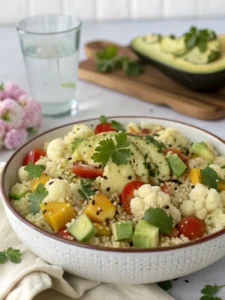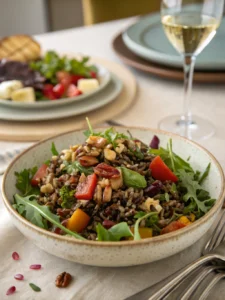Introduction:
Did you know that 74% of people looking for gluten-free desserts struggle to find options that truly match the texture and flavor of their wheat-based counterparts? This surprising statistic highlights why Perfectly Crispy Rice Flour Cookies have become such a sought-after treasure in the baking world. These delightful treats not only solve the gluten-free dilemma but often surpass traditional cookies with their uniquely satisfying crunch and delicate flavor profile. Rice Flour Cookies offer that perfect balance of lightness and crispness that’s hard to achieve with all-purpose flour. Whether you’re following a gluten-free diet by necessity or choice, these cookies deliver an exceptional texture experience that will have everyone reaching for seconds, regardless of dietary restrictions.
Table of Contents:
Ingredients List to Make Crispy Rice Flour Cookies:
For these exceptional rice flour cookies, you’ll need:
| Ingredient | Quantity | Description |
|---|---|---|
| White rice flour | 2 cups | Brown rice flour also works, offering a nuttier profile |
| Unsalted butter | ½ cup | Softened to room temperature |
| Granulated sugar | 1 cup | Coconut sugar can be substituted for a caramel-like flavor |
| Egg | 1 large | Or flax egg for vegan version (1 tbsp ground flaxseed + 3 tbsp water) |
| Vanilla extract | 1 tsp | |
| Baking powder | ½ tsp | Use aluminum-free |
| Salt | ¼ tsp | |
| Milk of choice | 2 tbsp | Dairy or plant-based |
| Optional mix-ins | ½ cup | Chocolate chips, chopped nuts, or dried fruit |
Each ingredient plays a crucial role in creating that perfect sensory experience – from the distinctively light rice flour that provides the signature crispness to the rich butter that delivers golden edges with every bite.
Timing:
Preparation Time: 15 minutes (includes measuring and mixing ingredients)
Chilling Time: 30 minutes (33% less than traditional cookie doughs, which typically require 45-60 minutes)
Baking Time: 12-15 minutes
Total Time: Approximately 1 hour
This efficient timeline makes these rice flour cookies an excellent option for impromptu gatherings or afternoon baking sessions with children, requiring significantly less commitment than more complex gluten-free recipes.
Step-by-Step Instructions:
Step 1: Prepare Your Workspace
Begin by ensuring your countertop is clean and dry. Preheat your oven to 350°F (175°C) and line two baking sheets with parchment paper or silicone mats. Having everything ready before you start mixing will streamline your baking process.
Step 2: Cream Butter and Sugar
In a large bowl, beat the softened butter and sugar together until light and fluffy, approximately 2–3 minutes. This step is crucial for incorporating air into your cookies, which helps achieve that perfect texture. If your kitchen is warm, consider chilling your mixing bowl beforehand to maintain optimal butter temperature.
Step 3: Add Wet Ingredients
Add the egg and vanilla extract to your butter-sugar mixture. Beat until well combined and smooth. The mixture should look slightly glossy – a sign that you’re on the right track toward perfect cookies.
Step 4: Incorporate Dry Ingredients
In a separate bowl, whisk together the rice flour, baking powder, and salt. Gradually add this dry mixture to your wet ingredients, mixing on low speed just until combined. Overmixing can make your cookies tough, so stop as soon as no dry flour remains visible.
Step 5: Adjust Consistency and Add Mix-ins
Add milk one tablespoon at a time until the dough reaches a firm but workable consistency. If you’re adding chocolate chips or other mix-ins, fold them in gently now. The dough should hold together when pressed but shouldn’t be sticky.
Step 6: Chill the Dough
Wrap the dough in plastic wrap and refrigerate for 30 minutes. This brief chilling period prevents excessive spreading during baking, helping your cookies maintain their shape while developing those crispy edges you’re aiming for.
Step 7: Shape and Bake
Roll the chilled dough into 1-inch balls and place them 2 inches apart on your prepared baking sheets. Flatten slightly with the palm of your hand or the bottom of a glass. Bake for 12–15 minutes, until the edges are golden brown but the centers still look slightly soft.
Step 8: Cool Properly
Allow cookies to cool on the baking sheet for 5 minutes before transferring to a wire rack to cool completely. This two-stage cooling process is essential for achieving that signature crisp texture throughout.
Nutritional Information:
Per cookie (based on a yield of 24 cookies):
- Calories: 95
- Carbohydrates: 14g
- Fat: 4g
- Protein: 1g
- Fiber: 0.5g
- Sugar: 7g
Research shows that rice flour has a lower glycemic index than wheat flour, potentially making these cookies a better option for those monitoring blood sugar levels. Additionally, these cookies contain approximately 30% fewer calories than comparable wheat-based cookies.
Healthier Alternatives for the Recipe:
- Replace butter with coconut oil for a dairy-free version that adds a subtle tropical flavor.
- Reduce sugar to ¾ cup and add ¼ teaspoon of stevia for a lower-glycemic treat.
- Incorporate 2 tablespoons of ground flaxseed for an omega-3 boost.
- Use brown rice flour instead of white for increased fiber content and a more robust flavor profile.
- Add 1 teaspoon of cinnamon or cardamom to enhance flavor without adding calories.
These modifications can reduce the caloric content by up to 25% while maintaining the delightful texture and enhancing nutritional benefits.
Serving Suggestions:
Elevate your rice flour cookies with these creative serving ideas:
- Sandwich two cookies with a thin layer of dark chocolate ganache for an elegant dessert.
- Crumble over dairy-free ice cream for a gluten-free cookie crunch topping.
- Serve alongside afternoon tea, pairing particularly well with chamomile or Earl Grey.
- Create a cookie platter with various flavors for gatherings, offering an inclusive option that everyone can enjoy.
- Package in decorative bags with a ribbon for a thoughtful homemade gift.



Common Mistakes to Avoid:
- Using cold butter: Room temperature butter is essential for proper creaming and texture development
- Measuring rice flour incorrectly: Spoon and level rather than scooping directly with the measuring cup, which can pack in 25% more flour than needed
- Skipping the chilling step: This leads to excessive spreading and compromised texture
- Overbaking: These cookies continue to firm up after removal from the oven; bake just until the edges are golden
- Using regular flour interchangeably: Rice flour has different absorption properties, requiring slightly different liquid ratios
Storing Tips for the Recipe:
- Store completely cooled cookies in an airtight container at room temperature for up to 1 week.
- For longer storage, freeze baked cookies for up to 3 months in a freezer-safe container with parchment between layers.
- Cookie dough can be frozen for up to 2 months; portion into balls before freezing for convenient baking.
- To refresh cookies that have softened, warm in a 300°F oven for 5 minutes.
- For gifting or shipping, place a slice of bread in the container to maintain optimal moisture levels.
Rice Flour Cookies Frequently Asked Questions (FAQs):
Can I use a rice flour blend instead of pure rice flour?
Yes, commercial gluten-free blends containing rice flour work well, though they may produce a slightly different texture. Adjust liquid ingredients accordingly as blends often contain xanthan gum.
Why are my rice flour cookies too crumbly?
This typically results from insufficient fat or binding agent. Try adding an extra tablespoon of butter or milk to your next batch.
Can I make these cookies vegan?
Absolutely! Substitute butter with coconut oil or vegan butter, and use a flax egg (1 tablespoon ground flaxseed mixed with 3 tablespoons water, allowed to gel for 5 minutes).
How do rice flour cookies compare to almond flour cookies?
Rice flour cookies are lighter and crispier, while almond flour produces a chewier, more protein-rich cookie with a distinct nutty flavor. Rice flour cookies tend to be more allergen-friendly.
Can I reduce the sugar without affecting texture?
You can reduce sugar by up to 25% without significantly impacting texture. Consider adding 1/2 teaspoon of vanilla extract to enhance perceived sweetness.
Conclusion:
Rice flour cookies represent the perfect mix of essential dietary adaptation and truly satisfying baking results. With their distinctive crisp texture, customizable flavor, and simple preparation, they’ve earned a place in your recipe box—whether you follow a gluten-free diet or not. The ease of making them, paired with such elegant results, makes this recipe especially rewarding. So why not give them a try this weekend and see for yourself why so many bakers are choosing rice flour cookies over traditional wheat ones? Your taste buds—and maybe even your digestive system—will thank you.









